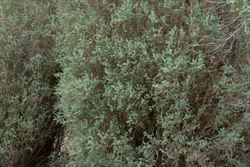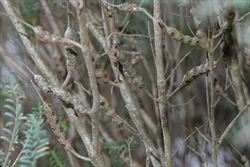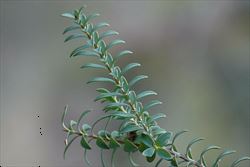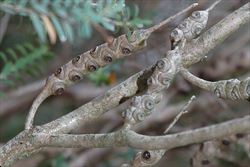Click on images to enlarge

habit (Photo: Rob and Fiona Richardson)

older stems with embedded clusters of fruit (Photo: Rob and Fiona Richardson)

younger stems and leaves (Photo: Rob and Fiona Richardson)

close-up of decussate leaves (Photo: Rob and Fiona Richardson)

close-up of mature fruit (Photo: Rob and Fiona Richardson)
Scientific Name
Melaleuca decussata R. Br.
Synonyms
Melaleuca decussata R. Br. var. decussataMelaleuca decussata R. Br. var. ovoidea J.M. BlackMelaleuca elegans Hornsch.Melaleuca parviflora Rchb.Melaleuca tetragona Lodd. ex OttoMyrtoleucodendron decussatum (R. Br.) Kuntze
Family
Myrtaceae
Common Names
cajeput, cross honey myrtle, cross leaf honey myrtle, crossed leaved honey myrtle, cross-leaf honey myrtle, cross-leaf honey-myrtle, cross-leaved honey myrtle, cross-leaved honey-myrtle, totem poles, totem-poles
Origin
Native to south-eastern Australia (i.e. Victoria and southern South Australia).
Naturalised Distribution
Naturalised beyond its native range in Victoria.
Notes
Cross-leaved honey-myrtle (Melaleuca decussata) is regarded as an environmental weed in parts of Victoria that are outside its native range. This species is widely cultivated as a garden ornamental in south-eastern Australia. It has escaped cultivation and become naturalised in grasslands and grassy woodland. It can also form relatively dense stands in native pastures following disturbance or clearing.
Cross-leaved honey-myrtle (Melaleuca decussata) is thought to pose a serious threat to one or more vegetation formations in Victoria and is listed as an environmental weed in several regions in this state (e.g. in the Geelong area, the Goulburn Broken catchment, and the Wimmera bioregion).

